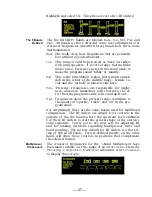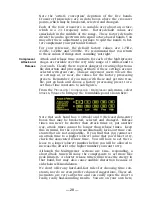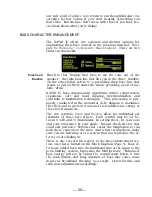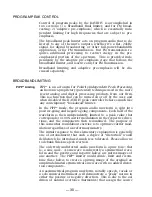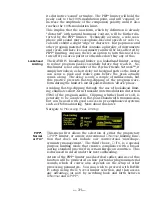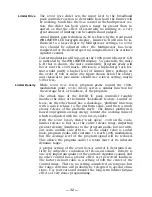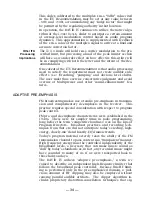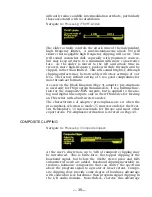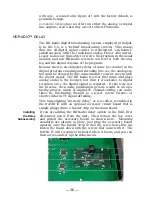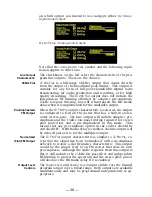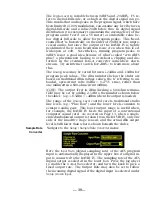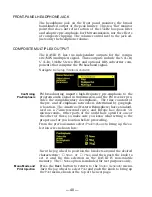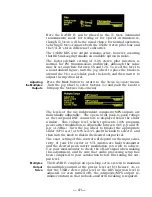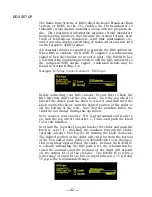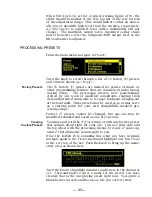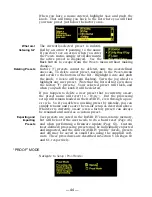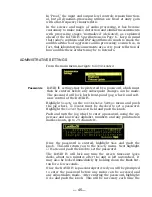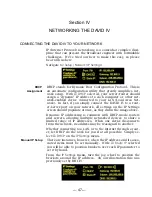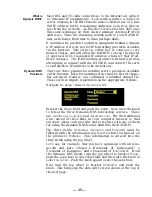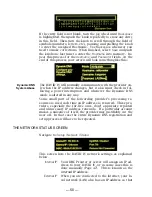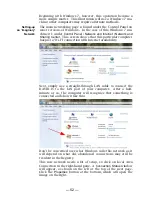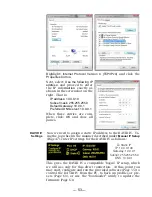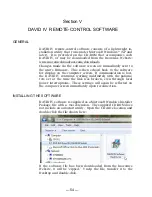
— 39 —
The
Digital Level
is variable between 0dBFS and –20dBFS. FS re-
fers to digital-full-scale, or as high as the digital signal can go.
This means that audio peaks in the program signal, which have
been limited to 100% modulation, can assume any level between
digital-full-scale and a value 20dB below this. In digital signal
distribution it is customary to maintain the
average
level of the
program audio (“zero” on a VU meter) a comfortable value be-
low digital full scale to allow for program peaks. This ‘head-
room offset’ is historically on the order of 20dB for raw, unpro-
cessed audio, but since the output of the DAVID IV is tightly
peak-limited there is no headroom issue even when this is set
wide-open at
0dB
. Nevertheless, running program peaks to
0dBFS is not a good idea because of what’s called “zero dBFS
plus,” a phenomenon leading to overshoots, clipping and dis-
tortion in the eventual D-to-A converter somewhere down-
stream. Try an Internet search for:
dBFS+
to learn more about
this.
The
Analog Level
may be varied b24dBu and –10dBu for
program peak values. The dBu numbers below the slider are
based on traditional dBm voltage values, the ‘u’ referring to un-
loaded, open-circuit volts (0dBu = 0.775V r.m.s), rather than
one milliwatt in a 600-ohm circuit (0dBm).
NOTE:
The output level in dBm (feeding a 600-ohm termina-
tion) may be set by adding 2.5dB to the numbers shown below
the slider. (e.g.: +6.5dBu = +4dBm when the output is loaded.)
The range of the
Analog Level
control covers traditional studio
line levels (e.g.: “Plus Four”) and the lower levels common to
semi-pro audio gear. This lower output range is useful when,
for example, the DAVID IV feeds the input of a conventional
computer sound card. As covered on Page 13, when a single-
ended unbalanced output is taken from the DAVID IV, only one
side of the line-drive stage is used, and the actual dBu output
level is 6dB lower than what is shown beneath the slider.
Sample Rate
Converter
Navigate to the
Setup / Sample Rate Converter
menu:
Here the
Input Rate
(digital sampling rate) of the AES program
input is automatically displayed in the upper box if a digital in-
put is connected to the DAVID IV. The sampling rate of the AES
digital output is selected in the lower box.
Press
the jog wheel
to enable the
Output Rate
selector, and
turn
the knob to pick a
fixed output rate. The Output Rate may also be set to follow
the incoming digital signal if the digital input is selected under
Setup / Audio Input
.
Summary of Contents for 719
Page 1: ...DAVID IV FM Audio Broadcast Processor Installation User Guide www inovonicsbroadcast com ...
Page 2: ......
Page 4: ......
Page 70: ... 66 NOTES AND DOODLES ...



